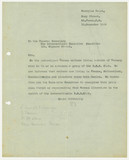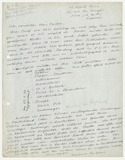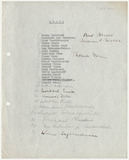Emil Ludwig
Ich habe die Ehre, zu Ihnen im Namen der vertriebenen und ausgewanderten deutschen Schriftsteller zu sprechen. Persönlich habe ich das Glück, auf Grund eines in meinen Jugendjahren gefaßten Entschlusses vor 30 Jahren in die Schweiz ausgewandert und seit langer Zeit Schweizer Bürger zu sein. Aber ich bin immer deutscher Schriftsteller gewesen und an einem Mai-Nachmittag des Jahres 1933 habe ich die Ehre gehabt, das Schicksal meiner besten Gefährten auf einem gewissen Scheiterhaufen zu teilen. Ich nahm einen Platz zwischen Heinrich Heine und Spinoza ein, und es schien mir würdiger, zwischen zwei Genies der Rasse verbrannt als von einigen rassekundigen Professoren beweihräuchert zu werden.
[I have the honour of speaking to you on behalf of all the German emigrant writers who were expelled from their country. Following a resolution I formed in my youth, I personally had the good fortune to emigrate to Switzerland 30 years ago and have now been a Swiss citizen for a long time. However, I have always been a German writer, and one May afternoon in 1933, I had the honour of sharing the fate of my most esteemed colleagues whose works were consigned to a certain pyre. I took a place between Heinrich Heine and Spinoza, and it seemed to me to be more noble to be incinerated between two geniuses of my race than to be praised to the skies by a few professors claiming racial expertise. (trans. ed.)]
Emil Ludwig’s speech at the PEN congress in Buenos Aires, 1936
| Born | on 25 January 1881 in Breslau, German Reich (now Poland) |
|---|---|
| Died | on 17 September 1948 in Ascona, Switzerland |
| Exile | Switzerland, United States of America |
| Profession | Writer |
One figure who featured largely in the history of exile literature was Emil Ludwig, who achieved worldwide fame and enjoyed huge print runs of his psychologically and psychopathologically accentuated historical biographies of Bismarck, Goethe, Wilhelm II and Napoleon. These were written for a fashionable readership during the years of the Weimar Republic. Ludwig had already been living in Ascona on the shores of Lago Maggiore since 1906 and obtained Swiss citizenship in 1932, before the National Socialists came to power. However, he gradually became persona non grata in the exile community because of the critical remarks he made about his fellow émigrés. The descriptions of Ludwig in the autobiographies of Hans Sahls and Elias Canetti speak volumes. However, unlike the successful author Erich Maria Remarque, who also lived in Ticino, Ludwig was committed to the cause of people in exile, opening his home to refugees and supporting aid organisations. The Nazis abhorred Ludwig, not least because of his success. Goebbels in particular feared his influence, and insisted on calling him by his original Jewish surname, “Cohn”. On 10 May 1933, the Nazis burnt Ludwig’s books on Berlin’s Opernplatz. Ludwig also incurred the displeasure of the authorities in Switzerland because of his support for the Jewish student David Frankfurter, who assassinated Wilhelm Gustloff, head of the Swiss branch of the NSDAP, in Davos in 1936. Ludwig emigrated to the USA in 1940 and returned in April 1945.
Part of Emil Ludwig's estate is held at the Swiss Literary Archives in Bern.
Selected works:
Goethe (biography, 1920)
Napoleon (biography, 1924)
Wilhelm der Zweite [Wilhelm the Second] (biography, 1925)
Bismarck (biography, 1926)
Juli 1914. Den Söhnen zur Warnung [July 1914. To our sons, in warning] (historical text, 1929)
Mord in Davos [The Davos Murder] (1936)
Further reading:
Fuhrer, Armin: Emil Ludwig. Verehrt, verfemt, verbrannt. Eine Biografie. Reinbek: Lau-Verlag 2021.







